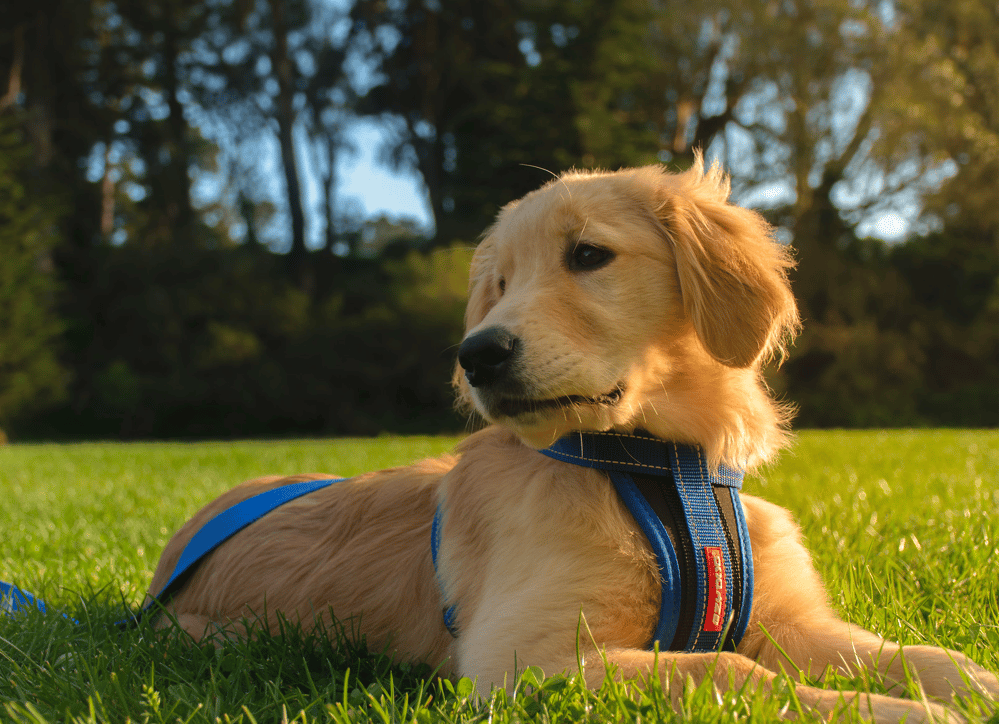Contents
- What to Expect From a 4-Month-Old Golden Retriever Puppy
- How Big Is A 4-Month-Old Golden Retriever?
- Socialization
- How Much Does A Four-Month-Old Golden Retriever Sleep?
- How Much Exercise Does A 4-Month-Old Golden Retriever Need?
- Training A Four-Month-Old Golden Retriever Puppy
- How Much Should a 4-month-old Golden Retriever Eat?
- How to Deal with Chewing and Biting
- Conclusion
By the time your Golden Retriever reaches 4 months old, there’s no denying that the once-tiny ball of fluff that you originally brought home has grown a lot!
Even though it’s obvious that you’re not going to be able to pick up and hold your pup with one hand like you could when you first brought them home, it’s important to remember that even if your pup is big, it’s still a puppy.
You’re going to notice a lot of growth and development from your pup at this stage. But to develop properly, your puppy needs your help and encouragement.
You’re probably at your wit’s end with your puppy’s biting right now. This is because the biting peaks at about 4 months old. So don’t worry, there’s light at the end of the tunnel and it will end soon!
We’ll tell you everything you need to know about how to be the best parent to your four-month-old fur baby in this article. Here are some of the things you’ll learn:
- Everything you can expect from a four-month-old Golden Retriever puppy
- The size of four-month-old Golden Retriever puppies
- How much does a four-month-old Golden Retriever sleep?
- The exercise needs of a four-month-old Golden Retriever puppy
- Training for a four-month-old Golden Retriever
- Feeding four-month-old Golden Retriever puppies
- How to deal with chewing and biting
What to Expect From a 4-Month-Old Golden Retriever Puppy
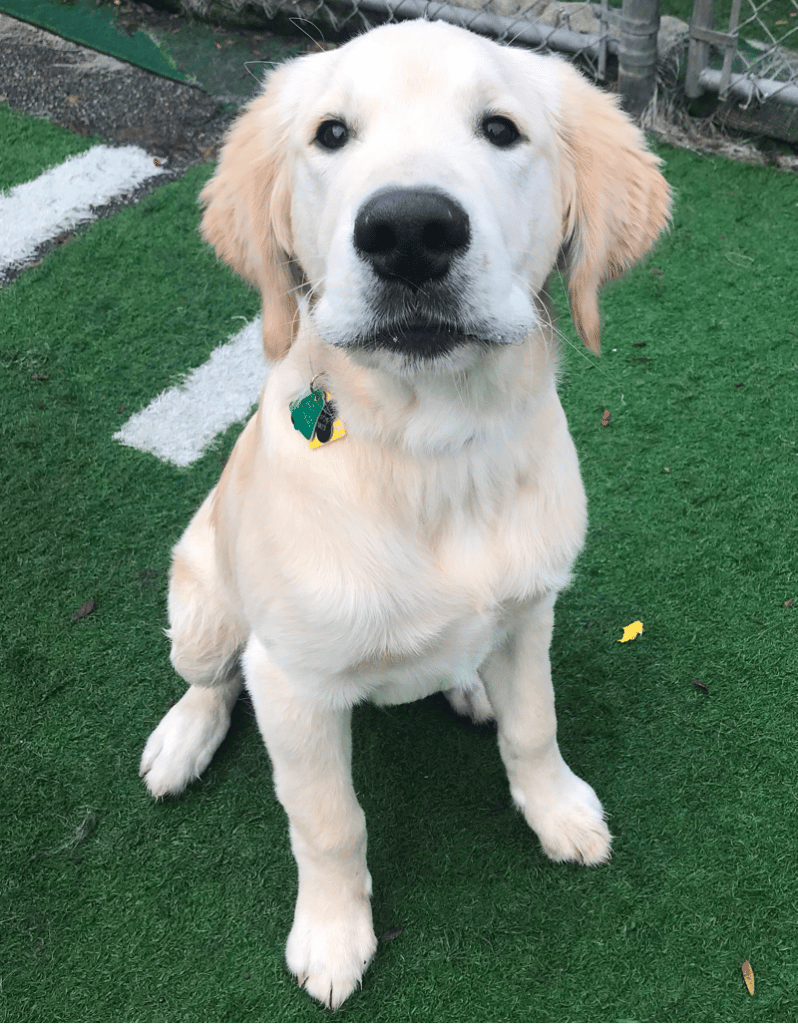
By now your puppy has been in your house for a couple of months and has learned about the rules and the way things work in their environment.
This means that your puppy is getting comfortable and falling into step with your daily routine. Because of this, things are a little less chaotic in dealing with your pup than they were when you first brought them home.
Your pup has probably learned that when you head over to where you store their food, it’s mealtime. And when you pick up their leash it’s time to go outside for a walk.
But your pup will throw you some curve balls because they’re still young. You may be cooped up inside working all day when your pup decides to start barking up a storm because they’re feeling playful. Or they may start doing new things because they’re tall enough to do them now, like getting up on your kitchen counters or the dining room table.
This experimentation isn’t some sort of unruly or disruptive behavior that your pup has suddenly developed. It just means that they’re learning more about their world and that you have new things to teach them. You didn’t have to tell them not to get up on the counters before because they couldn’t reach them and it didn’t seem necessary before, right?
When your pup pushes boundaries and does new things, this is actually a sign of intelligence and mental development, neither of which are bad things.
Your puppy will also have more energy, stamina, and coordination than they had in the previous weeks.
You’re going to need to find ways to help them burn off all of this extra energy. You definitely don’t want to leave them to their own devices in this regard because now they can get into more advanced levels of trouble and cause destruction for longer than before!
Don’t forget to engage their big brains, either. A Golden Retriever puppy that’s bored is bad news.
And since this is peak teething time, you’ll need to be engaging with your pup more so that they don’t chew up everything you love.
How Big Is A 4-Month-Old Golden Retriever?
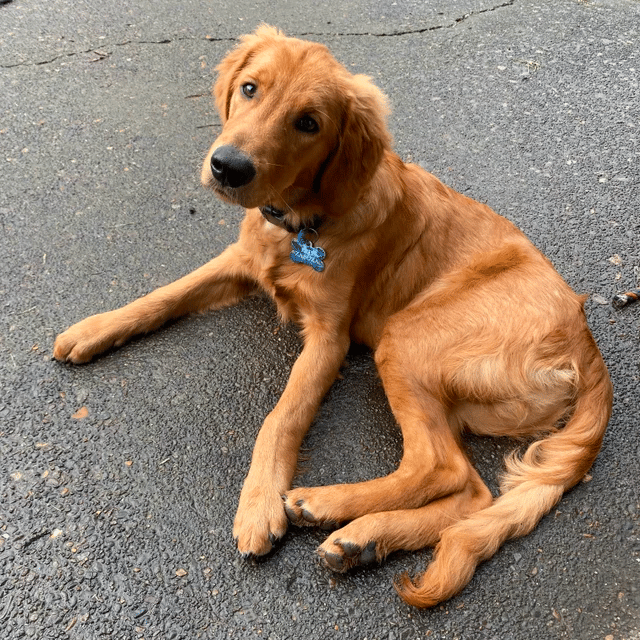
Your 4-month-old Golden puppy is going to start looking lanky, with legs that look like they’re too long for the rest of their body.
Their coat will also look a bit odd. They’ll start losing their fluffy puppy coat in favor of a more coarse adult coat. This will result in some random patches of fluff.
People often refer to this awkward stage as the “puppy uglies”, but it’s honestly more cute than ugly.
At 4 months old, your golden should be roughly half of its adult height. Since male goldens are between 22-24 inches tall on average, and females are 20-22, then your pup should be around 11- 12 inches if it’s male and 10- 11 inches if female.
When it comes to how much they should weigh, the average is around 20-40 lbs. But there are lots of factors that can affect your pup’s weight.
There are different types of Golden Retrievers and they come in all sizes. This means that what’s normal for a red golden isn’t the same as what’s normal for a show golden.
Heredity plays a part, as well. If your pup had small parents, then your pup will likely be a little smaller.
And if your puppy was seriously ill for a prolonged period of time, then it may have inhibited its ability to grow properly when compared to healthy puppies. Infestations of intestinal worms can stunt a puppy’s growth because they won’t get the necessary nutrients to grow. But usually, once the worms have been eliminated, the puppy will start to grow normally again.
No matter what case you’re dealing with, if you think your puppy is underweight, you should consult your veterinarian. They’ll be able to tell you if your pup is the right size and about any steps, you can take to help your puppy grow and stay healthy.
Socialization
By the time your pup has reached four months old, the “critical socialization window” has closed.
This means that your puppy will have already learned a lot of the socialization skills it needs to develop properly. The socialization your pup experienced prior to their four-month milestone will affect their behaviors and temperament going forward with their lives.
Hopefully, you let your puppy go on adventures into the world and they had safe positive experiences.
Just because your pup’s socialization window has closed doesn’t mean you should stop working on it. You should still take them out in public and teach them how to be well-behaved.
If your pup hasn’t been socialized before it turned four months old, then socializing it now won’t necessarily be a substitute for proper socialization during the appropriate time period. But that doesn’t mean it’s a waste to socialize them now, either.
You still need to keep your socialization light-hearted and safe. Don’t bring your puppy into any potentially scary situations. Your puppy is a baby animal, and they can become traumatized the same as human infants can.
You also need to be more patient with them during this time period. It’s easy to look at this big pup and think “They should know better by now”, but in all actuality, they’re still a baby and they’re still learning.
You’re their teacher, as well as their safe place.
While you continue showing them the world and how they should act in it, you need to also show them that you’re their caregiver and friend and that you’re safe, trustworthy, and fun.
How Much Does A Four-Month-Old Golden Retriever Sleep?
Your four-month-old Golden Retriever puppy will sleep somewhere between 11 and 18 hours per day.
While your puppy will be really energetic and hyper and your instinct may be to give them lots of exercises to burn off the extra energy, this can actually backfire on you. If you exercise your pup to the point that they’re over-tired, they’ll act up and get wild. They’ll bark, bite and become speed demons that bounce off the furniture (and maybe the walls).
To avoid an overly- tired puppy, make sure your pup is getting naps in. Sure, they may look more like an adult, but that doesn’t mean that they don’t still need naps!
The problem is that puppies aren’t good at settling down and getting themselves to sleep, much like human infants aren’t. You’ll need to help soothe them to sleep.
You can use a crate or pen to help confine them to their sleep area. In fact, if you get them into a routine where you put them in their crate every day for nap time, they’ll be more likely to acclimate to this routine and go down for a nap easier.
Developing a nap time routine is quite easy. Once your puppy has eaten, played, and went potty, you can put them in their crate with a soft toy to chew on. (Puppies chew to soothe themselves to sleep. It’s the equivalent of sucking on a pacifier.)
It’s a good idea to cover the crate with a towel or blanket to block out visual stimuli, and you can turn on white noise to block out distracting noises and make it easier for your pup to fall asleep.
If your puppy is acting rowdy, the first thing you should consider is whether they’re tired. More often than not, if a puppy is acting unruly, it’s because they’re over-tired.
How Much Exercise Does A 4-Month-Old Golden Retriever Need?
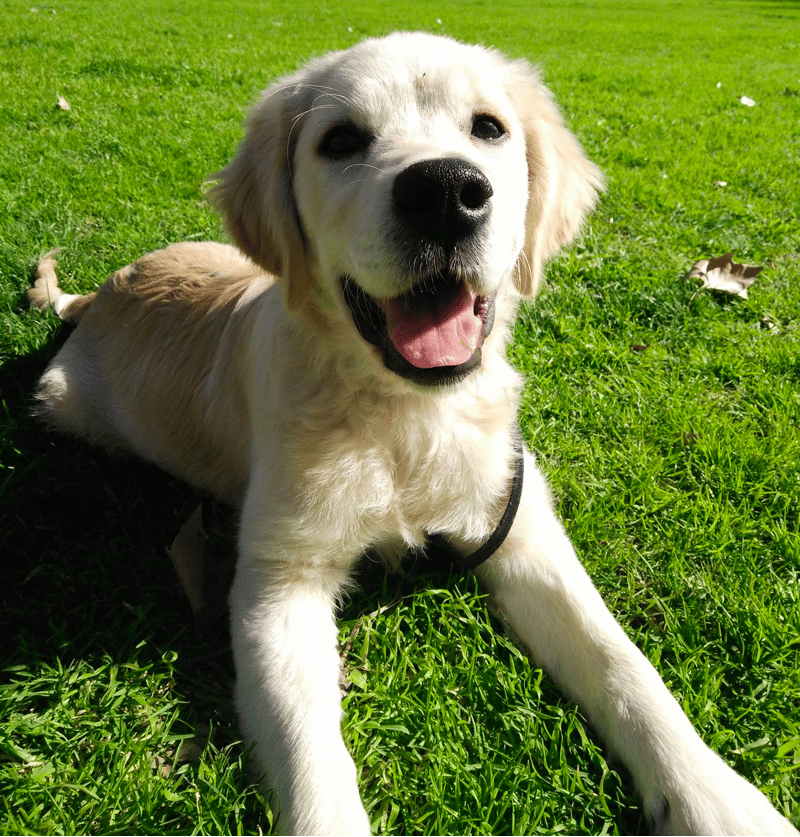
As I’ve stated, it’s not a good idea to over-exercise your pup. Intense exercise and prolonged repetitive motions can even cause injury to their developing joints and muscles. Not to mention the fact that when puppies are over-stimulated and exhausted it causes them to act up.
So, how much exercise should a four-month-old Golden Retriever puppy get?
Your pup has more energy than they did last month, so they can now go on walks for 15- 20 minutes at a time.
In general, you should let your puppy decide how much exercise they can handle.
If your puppy stops and decides to lay down in the middle of the walk, let them. They obviously need a break. Give them a few minutes to re-charge and don’t start again until they get up.
Even at 4 months old, your pup doesn’t have quite the full amount of energy that an adult golden has. So, you can’t treat them as your exercise partner quite yet.
By the time they reach this age, golden puppies should be up to date with their vaccinations, which is great because they love the outdoors.
The type of exercise that your Golden Retriever puppy will likely enjoy the most involves unstructured play outside. So, let them explore and romp around to their heart’s content. And even if it’s your instinct to keep them close to you and on a short leash, you should let them roam around a bit to get their exercise in.
Originally, Golden Retrievers were bred to hunt and do fieldwork, and your golden puppy will likely love the outdoors because of this.
If you find a small pond or safe body of water, it’s a good time to let your pup swim. You can gently put them in the water, or allow them to get in themselves. Most swimming will come naturally to them and they’ll follow their instincts.
People who live in more urban environments will find that their golden pups will enjoy walks around the neighborhood.
If your pup wants to stop and sniff at something while you’re on a walk, let them. You may not smell anything, and that leaf may seem pretty boring to you, but that’s because our primary senses involve sight, while theirs involve smell. Smells will engage brains and provide mental stimulation.
Training A Four-Month-Old Golden Retriever Puppy
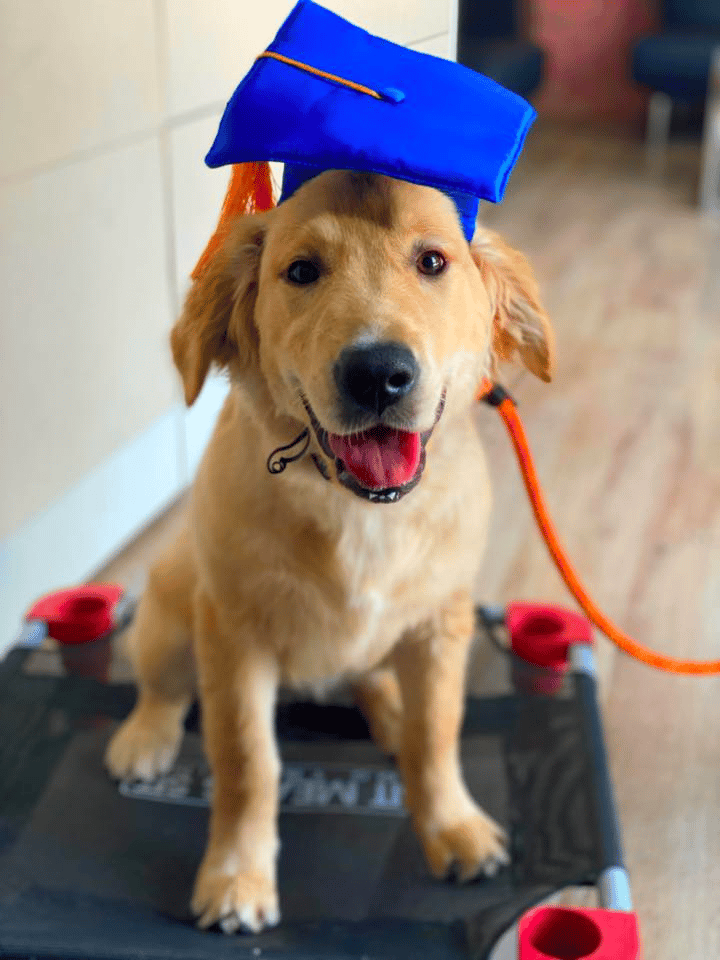
Of course, you’ve likely been working to train your pup for weeks already. But you aren’t finished quite yet.
You should be focused mainly on teaching your puppy to be comfortable with alone time, as well as potty training.
Some other things you can teach your pup during this time include:
- Dropping things when they pick up something they shouldn’t have
- Leaving it alone after they drop it
- Coming when called, even if there is a distraction
- Stop pulling when walking on a leash
- Lie down
It’s best to have short training sessions. You’d be surprised how much your pup will learn if you spend just a few minutes each day working with them.
Golden Retrievers respond best to positive reinforcement training tactics, which means you’ll need lots of treats.
Keep treats with you when you take your pup out on walks to reward positive behaviors and a good job on their leash.
You can work training sessions into things that are already part of your pup’s routine.
For instance, if you typically give your pup a treat when they come back inside from going potty, then you can use this opportunity to work with them to sit and stay and wait for their treat.
It’s important to train any puppy at this age, but it’s crucial for goldens. They’re so smart and full of energy that you need to make sure that they’re well-trained so that they’re not constantly in trouble.
Even though you’ve been working with your pup on potty training and they’ve got a bigger bladder now than when you first started training, don’t get too comfortable and slack off on the training. If you don’t keep working with them, they can regress and forget their training.
To work with them about being comfortable with being alone, you should put them in their crate or pen and then gradually stay out of their sight for longer and longer each time.
This takes practice. Many goldens feel most comfortable with their humans and get separation anxiety if they’re away from them for long. So this training is important. For more information about separation anxiety, check out our article about goldens and separation anxiety.
If at any time you feel like you can’t handle training your puppy, then there’s no shame in hiring a professional trainer. It’s literally what they exist for!
For more information about training, check out our article about training golden retriever puppies.
How Much Should a 4-month-old Golden Retriever Eat?
Your four-month-old golden pup should be eating 3 meals a day, spread throughout the day. They should be eating about 1 cup of food at each meal.
Your puppy’s individual food needs will be unique, so they may need less than this or more. Of course, because they’re growing, there will likely be a few days when they’re ravenous and 1 cup doesn’t quite cut it.
You’ll know if your puppy isn’t getting enough food throughout the day because, like many of us, they’ll get “hangry”.
But you don’t want to over-feed them.
Golden Retrievers have a major problem with overeating. Like us, they find food enjoyable and comforting too.
It’s such a problem that nearly 63% of adult Golden Retrievers are overweight.
A good rule of thumb to determine whether your pup is overweight is to pick them up. If you can’t feel their ribs when you’re holding or touching them, your pup may be overweight. Likewise, if you can see your pup’s ribs then it may be underweight.
To find out for certain whether your pup is the right weight, you should take them to the veterinarian and follow their recommendations.
If you’d like to know more about other health conditions that goldens are prone to, read our article about golden retriever common health issues.
How to Deal with Chewing and Biting
It probably seems like your golden pup has been teething the whole time you’ve known them, but you haven’t seen anything yet! Four months old is typically the peak chewing and biting period.
That may sound terrible, but it’s not the catastrophe you’re envisioning.
However, you should put any items you love up and out of the puppy’s reach.
The reason your puppy is chewing and biting more than usual is that their puppy teeth are falling out and they’re growing new teeth. This makes their gums uncomfortable and painful.
After they’ve completed the teething phase, you won’t have to deal with chewing and biting as much.
While you’re going through the teething period, you should make sure your puppy has a lot of toys and treats to chew on so that they don’t go after the furniture and other inappropriate items.
One of the traits that Golden Retrievers became such popular hunting dogs is that they have “soft mouths”. This means that they don’t chew and maul prey once their owner has shot it. Even if you’re not hunting with your puppy, you can use this to your advantage while your puppy is teething by giving them a soft stuffed animal to hold in their mouth.
You should also make sure that there are lots of chew toy options and chewy treats in your house so that your puppy can get the chewing out of their system without doing anything destructive.
If you find that your puppy is chewing on something that they shouldn’t be, just hand them something that they’re allowed to chew.
It’s important to remember that your puppy isn’t trying to be a holy terror. They’re just dealing with the fact that their mouth hurts the only way they know how.
Using pens and gates can be really useful during this time. They can not only keep your pup away from things they shouldn’t chew but they can be used as a “time out” if the puppy starts biting you. Just walk to the other side of the pen.
Read more about Tips and Tricks to Curb Your Golden Puppy’s Nipping and Play Biting
Conclusion
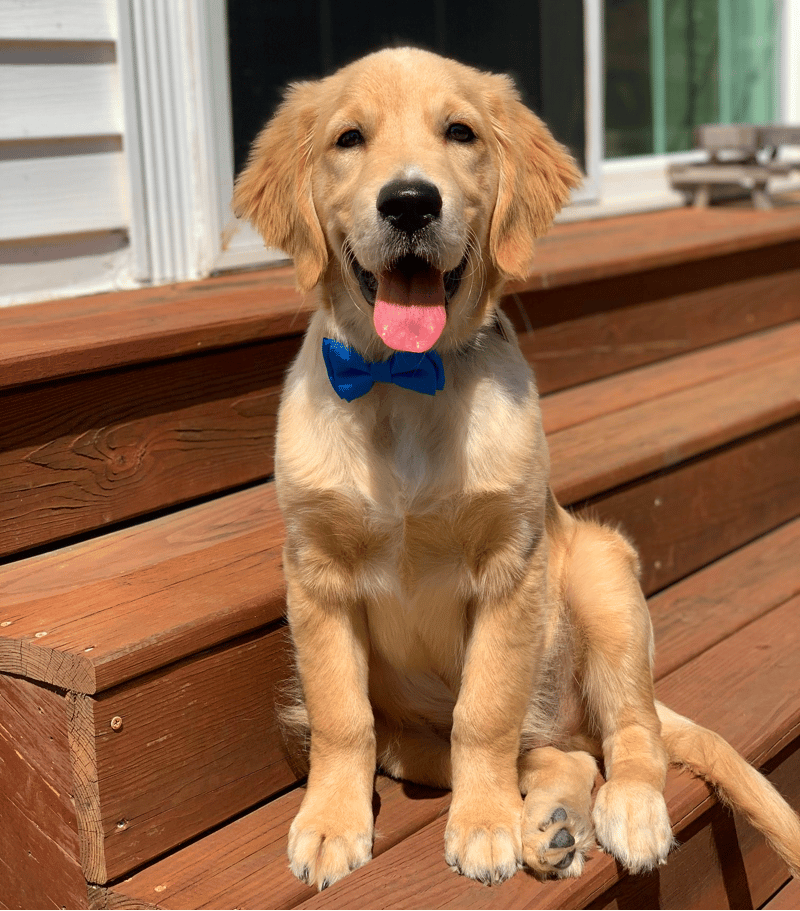
It’s surprising how quickly puppies grow. It wasn’t long ago you had a little round ball of fluff, and now you’ve got a puppy big enough that it’s hard to pick them up.
You’ll have a lot of times where training your puppy and caring for them can seem annoying and overwhelming, but for every stressful experience you have with your pup, there will be happy bonding experiences, as well.
It’s only a couple of months from this stage before your pup reaches its teenage years!
For now, all you need to do is make sure that you’re meeting all of your pup’s needs and caring for them, while also forming forever bonds with your lifelong friend.
If you haven’t found your Golden Retriever pup yet, check out our article about how to find reputable golden retriever breeders.
If you missed the other articles in this series, you can find them here:
- 6-Week-old Golden Retriever Puppies
- 8-Week-old Golden Retriever Puppies
- 3-Month-old Golden Retriever Puppies
- 5-Month-old Golden Retriever Puppies
- 6-Month-old Golden Retriever Puppies
- 7-Month-old Golden Retriever Puppies
- 8-Month-old Golden Retriever Puppies
- 1-year-old Golden Retriever Puppies
- 2-Year-Old Golden Retriever: Full-Grown, Adulthood, Playful
- Senior Golden Retriever: Signs of Aging and How to Care for Your Old Dog

